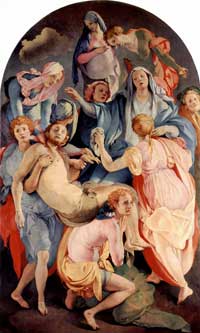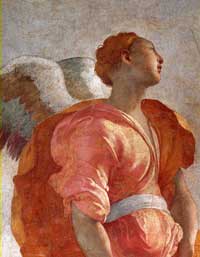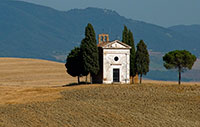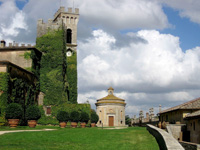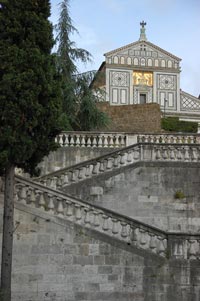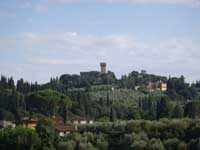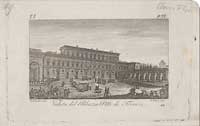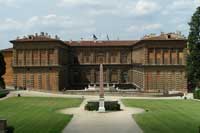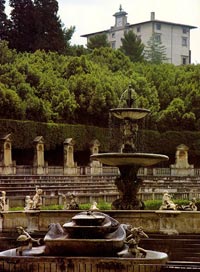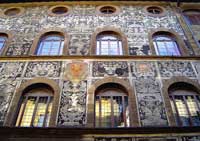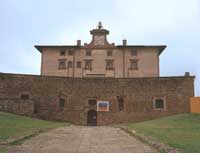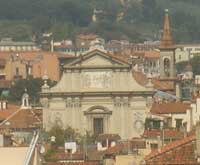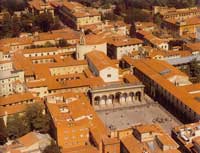San Niccolò Neighbourhood in Oltrarno |
|
Walking in Tuscany | Florence | San Niccolò Neighbourhood in Oltrarno |
| The tour starts at the southern end of the Ponte Vecchio, one of the eternal symbols of Florence. Notice the famous Corridoio Vasariano that crosses the bridge above the goldsmiths' shops, on over the Via Guicciardini and then disappears momentarily from sight. It is a suspended corridor built by artist and architect Giorgio Vasari in the 16th century to link the two Medici residences of Palazzo Vecchio and Palazzo Pitti, thus allowing the ducal family to move from one residence to the other without having to brush shoulders with the hoi polloi. Vasari's Corridor creeps around a tower at the southern end of the bridge, rather than passing through it. The Mannelli family, who owned the tower, refused to allow Duke Cosimo to bully them into letting him drive his private corridor through their property, so Vasari was forced to put the corridor out on stilts around the tower just for this short stretch. After admiring the statue of Bacchus by Giambologna in the Rossi-Cerchi tower on the corner diagonally opposite (now the Pitti Palace Hotel), carry on up Via Guicciardini . Almost immediately, you will see a small square across the street with a column in it, and behind the column a church façade with Vasari's Corridor running in front of it. The square is Piazza Santa Felicita, and the column in the middle (patiently pieced together again after its destruction in World War II) commemorates St. Peter Martyr's endeavours to extirpate the Patarene Heresy in the 13th century. |
The Vasari Corridor and Ponte Vecchio |
||
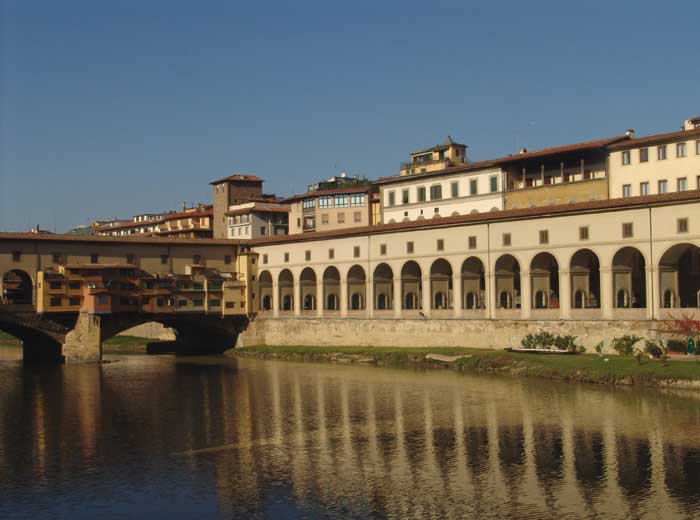 |
||
The Vasari Corridor and Ponte Vecchio, view from across th Arno |
||
| Passing under Vasari's Corridor, you now enter the church of 1 - Santa Felicita. Despite appearances (it was rebuilt to a design by Ferdinando Ruggeri in 1736), this is one of the oldest centres of Christian worship in Florence, built next door to what recent excavations have shown to have been a cemetery for the city's first Christian communities. The Cappella Capponi (architecture maybe by Brunelleschi) contains Pontormo's masterpiece, the Deposition, painted for this very chapel in 1526 and still in situ. [1] It has been called one of the greatest paintings in the world. Above your head as you admire the Pontormo painting, is the Medici grand dukes' private viewing gallery, leading off the inside of Vasari's Corridor.[2] From here the ducal family could take part in the religious services, again without having to mix with the masses. Totally different, but not to be missed, is the former Chapter House, the only remnant of the medieval convent, with its frescoes by Niccolò di Pietro Gerini. If you can successfully bribe the sacristan, you may even be lucky enough to visit the underground passages containingh a remnant of the original Roman Via Cassia, metres below the present-day street level. It was along this major consular road linking the Roman colony of Florentia to the capital, Rome, that Syrian merchants set up shop in the 4th century, outside the colony's walls and over a wooden bridge close to where the Ponte Vecchio stands today. They brought Christianity with them, and their community's cemetery lies under what is left of the cloister of Santa Felicita. Leave the church and turn right when you emerge from the porch. Turn right again, walking along the north side of the church into Piazza dei Rossi, and then start the climb up what may well be one of the steepest hills in Florence, Costa San Giorgio. The house of Galilei is along the suggestive Costa San Giorgio, immersed in its countryside villas. About halfway up, you see on your right 2 - San Giorgio (Romanian Orthodox Church of St. George). |
||
This ancient church was rebuilt in its present Baroque form by Giovan Battista Foggini in the 18th c. and contains several good pictures by Gherardini, Dandini and Passignano, as well as by Foggini himself, all worth seeing if the chuch is open (which is unlikely). But the most interesting thing here is the former monastery with its cloisters and conventual areas intact. It was used as a barracks until only a few years ago, and a battle is currently raging over what to do with this splendid space now the armed forces no longer need it. A luxury hotel? A cultural centre? The offices of the Fine Arts and Cultural Assets Superintendency? Who knows? By the time you visit it, a decision may have been reached, so if it is open and you can get inside, don't miss it! At the top of the hill, walk out of the small Medieval gate called the Porta San Giorgio. Turning right, you come immediately to the 3 - Forte Belvedere (Via di San Leonardo, 1), an important example of military architecture from the end of the 16th century. Fort Belvedere is sometimes called Forte di San Giorgio because of the name of the hill, and it was built by the Grand Duke Ferdinand I to the design of Bernardo Buontalenti. Star-shaped with triangular bastions, it also encloses the small Belvedere Palazzetto, also designed by Buontalenti. |
||
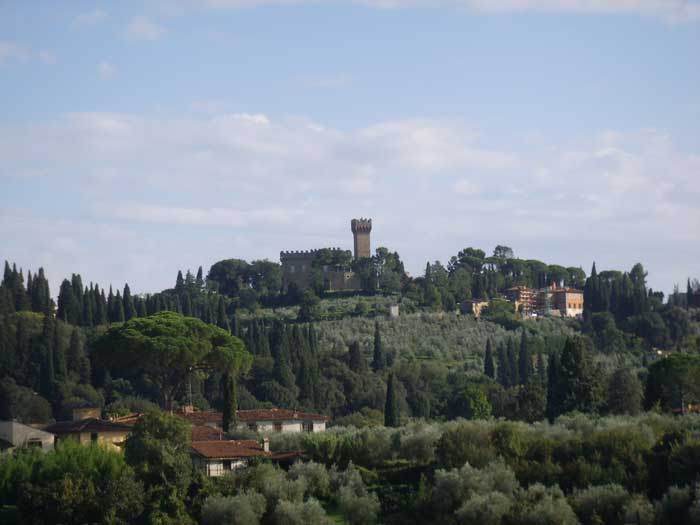 |
||
View of Arcetri area (in the hills above Florence)
|
||
Arcetri is a district of Florence, in the hills to the south of the city centre. A number of historic buildings are situated there, including the house of the famous scientist Galileo Galilei (called Villa il Gioiello), the Convent of San Matteo and the Torre del Gallo. The Osservatorio Astrofisico di Arcetri is also located here. The church of San Leonardo in Arcetri is the main church of the area. Galileo Galilei died here on January 8, 1642.
|
||
Further along the Via San Leonardo, a plaque on the wall indicates the house where Tchaikovsky stayed when visiting Florence in the winter of 1890. Returning now to the Forte Belvedere, turn right just before the Porta San Giorgio and walk down the Via di Belvedere, skirting one of the last remaining stretches of the city's medieval walls and coming to the gate known as the Porta San Miniato. Allegedly designed by Arnolfo di Cambio, the architect responsible for the Cathedral and Palazzo Vecchio among other things, this city gate still has its 13th century wooden doors. They were ripped off their hinges by the force of the furious flood of 1966, but in the end that proved to be the godsend they needed to persuade the authorities to restore them. |
||
| This Giardino Bardini is effectively the back garden of Palazzo de' Mozzi next door. Recently restored, it is one of the few extant examples of the kind of multifaceted garden many villas would have had from the Middle Ages right down to the last century. The history of the gardens goes back to the late 16th century when the Mozzi family acquired an estate just outside the city walls on the left bank of the Arno river. It consisted of a palazzo with a walled garden and a steep, terraced slope. In the 18th century Giulio Mozzi created a Baroque staircase on the slope adorned with sandstone statues. He also added a long fountain wall, decorated with mosaics. Financial struggles forced the Mozzi's to hand over the gardens to Carolath von Beuthen, who added Victorian elements. In 1913 the domain was acquired by Stefano Bardini, an antique dealer. He made some drastic changes and built a road to the villa, thereby demolishing the medieval walled garden. After the death of Bardini's son in 1965, the garden was neglected and it would take until 2000 before the Fondazione Parchi Monumentali Bardini Peyron, created to restore the estates of Bardini and Peyron, acquired the gardens and started a project to bring the gardens back to their original splendor. Finally, five years later the Bardini gardens opened to the public. Gardens in Tuscany | The Bardini Garden in Florence Links | www.bardinipeyron.it/bardini |
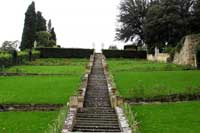 |
|
| After entering the garden via Via dei Bardi one passes a small rose garden. A wooded area ahead is the original English garden, once part of the Manadora estate. A winding path leads through the gardens uphill and brings you to the Villa Bardini, now home to a restaurant, cafeteria and bookshop. The path continues west to the top of the slope where you can take a break at the Kaffeehaus. From here you have a magnificent view over the city of Florence. On its way to the top the path passes along the central Baroque staircase, the centerpiece of the garden. On either side of the long staircase are terraced lawns and at its top is decorated with elegant statues. There are many other picturesque areas in the Bardini gardens which can be discovered by aimlessly wandering around the garden; you'll come across a grotto, several fountains, a small canal, a tempietto and an agricultural park with orchards. Depending on the time of the year the garden can be very colorful thanks to the many flowering plants, including roses, irises, hydrangeas and a beautiful wisteria pergola. |
||
| On leaving the garden, turn left and at the first junction (note the tabernacle housing '"the smallest art gallery in the world" - at the time of writing it contains one photo of... trees!), a short, if mildly strenuous, detour takes us up Costa Scarpuccia on our left, for some extremely photogenic glimpses of the city. A short way up Costa Scarpuccia, take the first right up Via del Canneto, which has to be one of the most atmospheric corners of "old Florence". At the top of the street, turn left up Costa de' Magnoli, then first left again down Costa Scarpuccia until you return to the tabernacle on the corner of Via de' Bardi. On your right as you set off down Via de' Bardi, you come to 7 - Santa Lucia de' Magnoli or Santa Lucia delle Rovinate ( St. Lucy in Ruins ). This church's second, rather curious name is due to its position, under the rather unstable hill of Costa San Giorgio. First built in 1078 to serve a hospice for pilgrims travelling to Rome (remember, we are outside the early Medieval walls here, on what was then the main road to Rome), it was damaged by landslides from "across the street" on numerous occasions. All trace of the hospice (in which St. Francis of Assisi, among many others, once stayed) has gone, but the church in its present, Renaissance form contains a fine picture of St. Lucy by Pietro Lorenzetti (early 14th c.) and two late 15th c. panels by Jacopo del Sellaio, a sometime colleague of both Botticelli and Filippino Lippi, depicting the Annunciation. The main altarpiece, a splendid mid-15th c. Sacred Conversation by Domenico Veneziano, has been moved to the Uffizi Galley and replaced by a rather drab offering by Agnolo di Donnino, nor is there any trace of a fresco cycle by Bicci di Lorenzo known to have once been here. As you emerge from the church, note the small (relatively modern) tabernacle across the road commemorating St. Francis' visit. No. 30, Via de' Bardi is the 15th c. Palazzo Larioni de' Bardi, attributed by some to Michelozzo (note the courtyard), while Palazzo Canigiani next to it is a fine example of the Florentine Neoclassical style, having been rebuilt in 1838. At no. 36, Via de' Bardi, you fin the Palazzo Capponi delle Rovinate, again owing its name to the frequent landslides in the area (notice a plaque on the wall opposite, dated 1565, banning any further building on that side of the street). This palace was built for leading early 15th c. Florentine oligarch Niccolò da Uzzano, apparently to a design by the young Brunelleschi, and its courtyard is considered to be one of the earliest examples of the Renaissance style. It is still lived in by Capponi family today and so, sadly, is not open to the public. |
||
Via de' Bardi ends at Piazza Santa Maria Sopr'Arno, with a fine view of the Uffizi across the river. The view, however, is relatively recent, because this square was once dominated by the important parish church of Santa Maria Soprarno (or "on the Arno"), sacrificed for reasons of space and safety when the river banks were built in the mid-19th c.
|
||
Piazzale Michelangelo [Magnificent View on Ponte Vecchio] |Photo by: Sergi Melki, Creative Commons |
||
| [1] The Barbadori Chapel, later Capponi Chapel, is a chapel in the church of Santa Felicita in Florence, central Italy. It was designed by Filippo Brunelleschi, and was later decorated by a cycle of works by the Mannerist painter Pontormo. Bartolomeo Barbadori commissioned the construction of a family chapel in the church around 1420. After the destruction of the Ridolfi chapel in San Jacopo sopr'Arno, this chapel is the oldest existing among those designed by Brunelleschi. Dedicated to the Virgin, it was most likely built to honor a fresco of the Annunciation, painted on the counter-façade. In the same point Pontormo frescoed the same subject. In 1487 the chapel was acquired by Antonio Paganelli, whose heir Bernardo Paganelli, in 1525, sold it to the Capponi family. The latter had it restored and decorated by Jacopo Pontormo, with help from a young Agnolo Bronzino. In 1722 Ferrante Capponi had the chapel restored again, adding a new altar with polychrome marble and closing it with a wrought iron enclosure which is still existing. A tondo by Pontormo, depicting the Madonna with Child, was perhaps moved in this period from the chapel to the Capponi private palace. The large altarpiece canvas for the Brunelleschi-designed Capponi Chapel in the church of Santa Felicita in Florence, portraying The Deposition from the Cross, is considered by many Pontormo's surviving masterpiece (1528). The figures, with their sharply modeled forms and brilliant colors are united in an enormously complex, swirling ovular composition, housed by a shallow, somewhat flattened space. Although commonly known as The Deposition from the Cross, there is no actual cross in the picture. The scene might more properly be called a Lamentation or Bearing the Body of Christ. Those who are lowering (or supporting) Christ appear as anguished as the mourners. Though they are bearing the weight of a full-grown man, they barely seem to be touching the ground; the lower figure in particular balances delicately and implausibly on his front two toes. These two boys have sometimes been interpreted as Angels, carrying Christ in his journey to Heaven. In this case, the subject of the picture would be more akin to an Entombment, though the lack of any discernible tomb disrupts that theory, just as the lack of cross poses a problem for the Deposition interpretation. Finally, it has also been noted that the positions of Christ and the Virgin seem to echo those of Michelangelo's Pietà in Rome, though here in the Deposition mother and son have been separated. Thus in addition to elements of a Lamentation and Entombment, this picture carries hints of a Pietà.[1] It has been speculated that the bearded figure in the background at the far right is a self-portrait of Pontormo as Joseph of Arimathea. Another unique feature of this particular Deposition is the empty space occupying the central pictorial plane as all the Biblical personages seem to fall back from this point. It has been suggested that this emptiness may be a physical representation of the Virgin Mary's emotional emptiness at the prospect of losing her son. On the wall to the right of the Deposition, Pontormo frescoed an Annunciation scene (at right). As with the Deposition, the artist's primary attention is on the figures themselves rather than their setting. Placed against white walls, the Angel Gabriel and Virgin Mary are presented in an environment that is so simplified as to almost seem stark. The fictive architectural details above each of them, are painted to resemble the gray stone pietra serena that adorns the interior of Santa Felicità, thus uniting their painted space with the viewer's actual space. The startling contrast between the figures and ground makes their brilliant garments almost seem to glow in the light of the window between them, against the stripped-down background, as if the couple miraculously appeared in an extension of the chapel wall. The Annunciation resembles his above mentioned Visitation in the church of San Michele at Carmignano in both the style and swaying postures. Vasari tells us that the cupola was originally painted with God the Father and Four Patriarchs. The decoration in the dome of the chapel is now lost, but four roundels with the Evangelists still adorn the pendentives, worked on by both Pontormo and his chief pupil Agnolo Bronzino. The two artists collaborated so intimately, that specialists dispute which roundels each of them painted. This tumultuous oval of figures took three years for Pontormo to complete. According to Vasari, because Pontormo desired above all to "do things his own way without being bothered by anyone," the artist screened off the chapel so as to prevent interfering opinions. Vasari continues, "And so, having painted it in his own way without any of his friends being able to point anything out to him, it was finally uncovered and seen with astonishment by all of Florence..."[Giorgio Vasari, The Lives of the Artists] |
|
|||
[2] After the Medici transferred their residence to Pitti Palace, Cosimo I commissioned in 1565 the architect Giorgio Vasari with the building of a corridor joining Palazzo Vecchio, the Uffizi and Pitti Palace. |
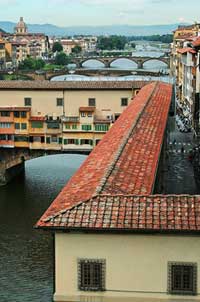 The West Corridor of the Gallery |
|||
|
||||
|
This article incorporates material from the Wikipedia articles Pontormo, Barbadori Chapel, published under the GNU Free Documentation License. The walking trail was based on one of the pages of Walking in Tuscany, From Ponte Vecchio to Piazzale Michelangelo and back.
|
||||
|
||||
Podere Santa Pia |
Podere Santa Pia |
Madonna di Vitaleta Chapel, San Quirico d'Orcia |
||
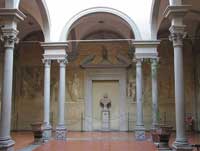 |
||||
Villa Celsa near Florence |
Piazza della Santissima Annunziata in Florence |
Choistro dello Scalzo, Florence |
||
| Historical buildings and monuments |
||||
|
Forte Belvedere Bardini Museum and Corsi Gallery Bardini Gardens Basilica di S. Miniato al Monte Chiesa di San Salvatore al Monte Chiesa di S. Leonardo |
||||
In 1418 the wealthy banker Luca Pitti bought the property from the Boboli family with the intention to build a palace equal to that of the Medici. The Pitti family wanted to impress their fellow bankers with an ostentatious display of his wealth of their family and highlight the fact they were wealthier and more successful than the banking dynasty of the Medici, their main rivals. |
|
|||
| The Forte di Belvedere or Fortezza di Santa Maria in San Giorgio del Belvedere (often called simply Belvedere) was built by Grand Duke Ferdinando I de' Medici during the period 1590–1595, with Bernardo Buontalenti as the designer, to protect the city and its rule by the Medici family. On the same side of the river as the Grand Ducal palace, the Pitti Palace in the Oltrarno district of the city, today the grounds provide spectacular outlooks over Florence; the buildings are used to hold works of art, and as a venue for exhibitions of contemporary sculpture. The design and construction of the Fort were entrusted to architect Bernardo Buontalenti, the chief architect for both Cosimo I and his son, Ferdinando. The Fort served many purposes: to protect the center of government in Florence, the Pitti Palace; to protect the south end of the city of Florence and the Oltrarno district; to demonstrate the power of the Medici family; hold the treasury of the Medici; and finally to provide a shelter for the Grand Duke if the city came under attack. The fort was connected to Palazzo Vecchio via the Vasari Corridor over Ponte Vecchio, passages in the Pitti Palace and paths through Boboli Gardens. Buontalenti applied contemporary fortification principles when he designed the Fort. The walls are designed at angles that allow for all the walls to be seen by another wall, allowing for cross fire to assist in protecting the other walls. The location where the fort was placed had long been considered of strategic importance since the time of Michelangelo, then head engineer of fortifications. An earlier version of the fort was built of earth and stone gabions as seen in frescoes in Palazzo Vecchio. In addition to being a fortification, the Belvedere was meant to be a sign of Medici prestige. The villa inside the fortress was designed to be elegant and did not adhere to the military purposes of the rest of the fort. Since the villa was meant to be used as the residence of the Grand Duke during times of unrest or epidemic, it was built as a comfortable, luxurious palace, another sign of Medici domination in Florence. The Fort served as a garrison for troops for over 100 hundred years after its completion. |
||||
| Palazzo Mozzi or Palazzo de' Mozzi is an early Renaissance palace in Florence, Italy. The palazzo was built by the Mozzi family between 1260 and 1273 as a fortification for the Ponte alle Grazie. The palazzo was modified in the 14th century to a Renaissance house. The Mozzi family often hosted prominent persons such as Pope Gregory X and the Duke of Athens at the palazzo.[1] In the 16th century, a plot of land was purchased behind the palazzo and was used to grow an olive grove. The grove was transformed into a garden in the 19th century when the palazzo was purchased by Stefano Bardini. The State of Italy currently owns the palazzo and it is undergoing restoration and conversion to an art museum. The Gallery of Palazzo Mozzi Bardinii is avast complex includes several buildings, a historical garden and approximately 30,000 works of art of various kinds and of different periods, acquired by the State in 1996. The collections were put together by the antique dealer Stefano Bardini (1836-1922) and his son Ugo. The Bardini Gardens offer wonderful views of Florence from its 4 hectares of parkland between the left bank of the Arno River, Montecuccoli Hill and the mediaeval wall. The Bardini Gardensis located on the hill right behind Palazzo Mozzi. It has been recently restored and reopened for visits. From its terrace we can see a wonderful panorama of Florence. The Garden is located on the Montecuccoli hill, which belonged to the Mozzi family since 12th Century. In 1259 a «market-garden» right behind Palazzo Mozzi is referred to in written records, and at the sime time terraces with vineyards existed in the upper part of the garden. Both palazzo and hill remained to the Mozzi family until 1880; the garden was enlarged during the time, when the Mozzis purchased a vast ground which now is the eastern part of the garden: a small villa, Villa Manadora, is located there. During 19th Century the garden was neglected; in 1880 Carolath Benten family purchased palace and garden but did not restore them. In 1913 Florentine antiquarian Stefano Bardini bought the whole garden and the palace: he restored and further decorated the garden, but demolished the mediaeval terraces which survived until then; he also enlarged the buildings on the side towards Costa San Giorgio. Gardens in Tuscany | The Bardini Garden in Florence |
||||
| Santa Lucia dei Magnoli is small and very old church flanked by the palaces of Via de' Bardi. Following a tradition, Saint Francis of Assisi and Saint Domenico met in 1211 in the hospital that was located at the side of the church. The church was founded in 1078 on the initiative of the noblesman Uguccione della Pressa, and was once known also under the names of Santa Lucia dei Bardi (from the most important family of the quarter) or Santa Lucia delle Rovinate (referring to the landslips of the near hill of San Giorgio). In 15th Century the church passed under the protection of the family Da Uzzano, who had built a palace near the church palazzo (today Palazzo Capponi delle Rovinate) and subventioned the frescoes in the main chapel. Other noble families (among them, Capponi and Mozzi) contributed to the decoration of the church: their coats of arms are to be seen on the façade and in the interior of the church. Santa Lucia was frequently damaged by the landslpis of the hill of San Giorgio, and was rebuilt (and modified) in 1732, but subsequent restorations in 19th and 20th Centuries re-discovered the structure and decorations of the 15th Century. The façade was restored a few years ago. on the façade is to be seen the Lunette in glazed terracotta showing Santa Lucia between two angels, a work ascribed to Benedetto Buglioni (1461-1521), from the workshop of the Della Robbia. There are also some Coats of arms and inscriptions mentioning benefactors of the church, and a Notice by the Signori degli Otto («the Lords of the Eight», commanders of the city police) of the year 1646, prohibiting «to make noise near the church». Interior: the church has a caisson ceiling and big side altars. Here are to be seen some important paintings: among them, the Santa Lucia, by Pietro Lorenzetti (1280-1348) commissioned by family Del Nente. The first altar on the left is decorated with a big painting by Jacopo da Empoli (1610), the Madonna with the Child and Saints. From the church one can enter the Chapel of the Madonna of Loreto, where is a Madonna brought to the sanctuary of Loreto by a group of Florentine priests in 1692. |
||||
| Casa Museo Rodolfo Siviero Casa Siviero is a small, 19th century villa on the banks of the River Arno, on the corner between Lungarno Serristori and Piazza Poggi. Its location at the foot of the steps leading to Piazzale Michelangelo and its Neo-Renaissance architectural style, typical of Giuseppe Poggi, leads us to believe that this architect, who was responsible for the urban redevelopment of Florence at the time when the city was Italy's capital, was also involved in the design of the house. The Museum Rodolfo Siviero is located at the ground floor of the fine Neo-Renaissance building on the banks of the river Arno, where Rodolfo Siviero lived from 1944 until his death in 1983. A keen collector and refined intellectual, Siviero managed to collect many works of Ancient art among which Etruscan findings; Ancient Roman busts; 14th and 15th century wooden statues; Medieval paintings on gold backgrounds, Renaissance and Baroque pictures, bronzes, terra-cottas, liturgical objects, beautiful furniture. Furthermore, a group of works of important Italian modern artists such as Giorgio De Chirico, Giacomo Manzù, Ardengo Soffici, Pietro Annigoni, who were friends of Siviero. Address: Lungarno Serristori, 550125 Florence | www.museocasasiviero.it |
||||
| Florence's historic restaurants | Antica Mescita San Niccolò Originally a customs station for wines that came through Porta di San Niccolò, in the early 1800s it was transformed into a wine bar and general store. After the 1966 flood the cellars were restored and a Romanesque crypt of the Church of San Niccolò was found there and it is now possible to eat in this suggestivs, 11th-century location. Since 1970 the osteria has been known by its present name. The furnishings, partially reconstructed with antique materials, re-create a typical wine bar atmosphere. Since 1993 the restaurant has been run by the Prosperi family who offer a traditional Tuscan menu and a broad choice of wines. Address: Antica Mescita S. Niccolò, Via San Niccolò, 60/r |
||||
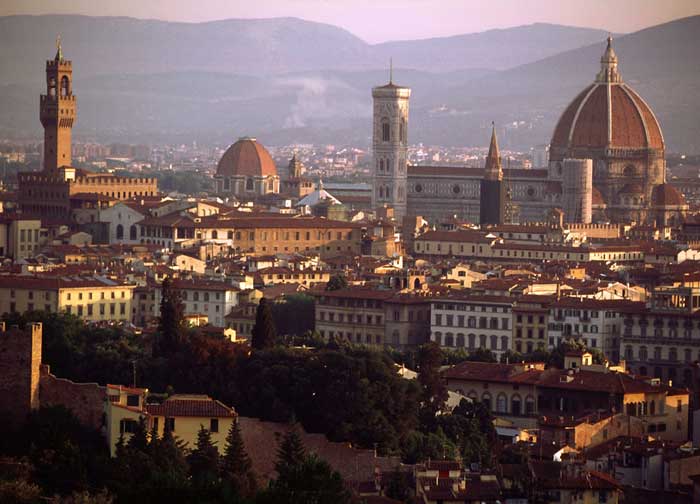 |
||||
Florence, panoramic view from Piazza Michelangelo |
||||
Piazza Michelangelo is on a hill on the south bank of the Arno River, just east of the center of Florence, and offers a stunning view of the city.
|
||||
| Choosing one of the Florence walking tours you'll be able to visit the world-famous museums of the Uffizi and Accademia Galleries, discovering the main historical and artistic treasures of the city. The tours focus on Florence's major sights and attractions, including the Duomo, the Ponte Vecchio and the city's famous churches and Renaissance palaces. Novelist Henry James called Florence a “rounded pearl of cities -- cheerful, compact, complete -- full of a delicious mixture of beauty and convenience.” The best way to experience the Italian city’s artistry, history and joy of life is by walking the same paths that the Medicis, Michelangelo and James once used. 1 | A Walk Around the Uffizi Gallery 2 | Quarter Duomo and Signoria Square 3 | Around Piazza della Repubblica 5 | San Niccolo Neighbourhood in Oltrarno 6 | Walking in the Bargello Neighbourhood 7 | From Fiesole to Settignano
|
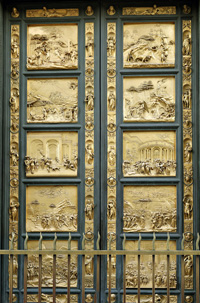 Baptistery, Duomo |
|||
The façade and the bell tower of San Marco in Florence |
Piazza della Santissima Annunziata in Florence |
Florence, Duomo |
||

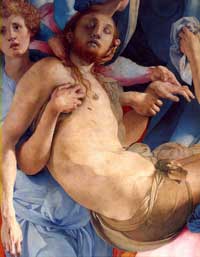
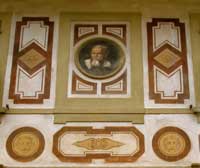
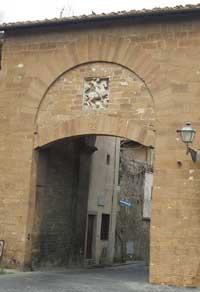
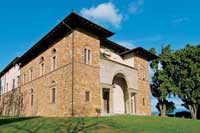
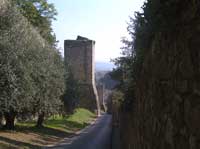
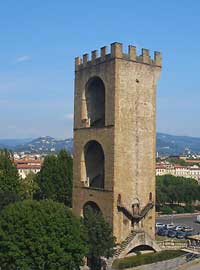
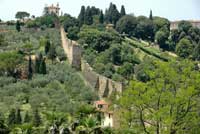
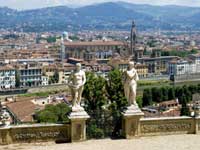
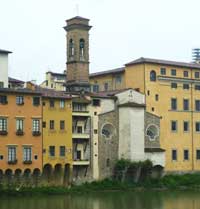
![Piazzale Michelangelo [Magnificent View on Ponte Vecchio]](/images/city/firenze/pontevecchio700.jpg)
